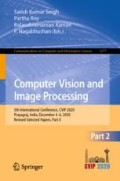Abstract
Removing non-uniform blur from an image is a challenging computer vision problem. Blur can be introduced in an image by various possible ways like camera shake, no proper focus, scene depth variation, etc. Each pixel can have a different level of blurriness, which needs to be removed at a pixel level. Deep Q-network was one of the first breakthroughs in the success of Deep Reinforcement Learning (DRL). However, the applications of DRL for image processing are still emerging. DRL allows the model to go straight from raw pixel input to action, so it can be extended to several image processing tasks such as removing blurriness from an image. In this paper, we have introduced the application of deep reinforcement learning with pixel-wise rewards in which each pixel belongs to a particular agent. The agents try to manipulate each pixel value by taking a sequence of appropriate action, so as to maximize the total rewards. The proposed method achieves competitive results in terms of state-of-the-art.
Access this chapter
Tax calculation will be finalised at checkout
Purchases are for personal use only
References
Chakrabarti, A.: A neural approach to blind motion deblurring. In: Leibe, B., Matas, J., Sebe, N., Welling, M. (eds.) ECCV 2016. LNCS, vol. 9907, pp. 221–235. Springer, Cham (2016). https://doi.org/10.1007/978-3-319-46487-9_14
François-Lavet, V., Henderson, P., Islam, R., Bellemare, M.G., Pineau, J.: An introduction to deep reinforcement learning. arXiv preprint arXiv:1811.12560 (2018)
Furuta, R., Inoue, N., Yamasaki, T.: Pixelrl: fully convolutional network with reinforcement learning for image processing. IEEE Trans. Multi. 22(7), 1702–1719 (2019)
Hyun Kim, T., Mu Lee, K.: Segmentation-free dynamic scene deblurring. In: Proceedings of the IEEE Conference on Computer Vision and Pattern Recognition, pp. 2766–2773 (2014)
Kingma, D.P., Ba., J.: Adam: A method for stochastic optimization. arXiv preprint arXiv:1412.6980 (2014)
Kupyn, O., Budzan, V., Mykhailych, M., Mishkin, D., Matas, J.: Deblurgan: blind motion deblurring using conditional adversarial networks. In: Proceedings of the IEEE Conference on Computer Vision and Pattern Recognition, pp. 8183–8192 (2018)
Li, D., Wu, H., Zhang, J., Huang., K.: A2-rl: aesthetics aware reinforcement learning for image cropping. In: Proceedings of the IEEE Conference on Computer Vision and Pattern Recognition, pp. 8193–8201 (2018)
Mnih, V., et al.: Asynchronous methods for deep reinforcement learning. In: International Conference on Machine Learning, pp. 1928–1937 (2016)
Mnih, V., et al.: Playing atari with deep reinforcement learning. arXiv preprint arXiv:1312.5602 (2013)
Nah, S., Hyun Kim, T., Mu Lee, K.: Deep multi-scale convolutional neural network for dynamic scene deblurring. In: Proceedings of the IEEE Conference on Computer Vision and Pattern Recognition, pp. 3883–3891 (2017)
Schuler, C.J., Hirsch, M., Harmeling, S., Schölkopf, B.: Learning to deblur. IEEE Trans. Pattern Anal. Mach. Intell. 38(7), 1439–1451 (2015)
Sun, J., Cao, W., Xu, Z., Ponce, J.: Learning a convolutional neural network for non-uniform motion blur removal. In: Proceedings of the IEEE Conference on Computer Vision and Pattern Recognition, pp. 769–777 (2015)
Tokui, S., et al.: Chainer: a deep learning framework for accelerating the research cycle. In: Proceedings of the 25th ACM SIGKDD International Conference on Knowledge Discovery & Data Mining, pp. 2002–2011 (2019)
Xu, L., Jimmy, S.J., Ren, C.L., Jia, J.: Deep convolutional neural network for image deconvolution. Adv. Neural Inf. Process. Syst. 27, 190–1798 (2014)
Zhang, K., Zuo, W., Gu, S., Zhang, L.: Learning deep CNN denoiser prior for image restoration. In: Proceedings of the IEEE Conference on Computer Vision Pattern Recognition, pp. 3929–3938 (2017)
Author information
Authors and Affiliations
Corresponding authors
Editor information
Editors and Affiliations
Rights and permissions
Copyright information
© 2021 Springer Nature Singapore Pte Ltd.
About this paper
Cite this paper
Singhal, J., Narang, P. (2021). DeblurRL: Image Deblurring with Deep Reinforcement Learning. In: Singh, S.K., Roy, P., Raman, B., Nagabhushan, P. (eds) Computer Vision and Image Processing. CVIP 2020. Communications in Computer and Information Science, vol 1377. Springer, Singapore. https://doi.org/10.1007/978-981-16-1092-9_37
Download citation
DOI: https://doi.org/10.1007/978-981-16-1092-9_37
Published:
Publisher Name: Springer, Singapore
Print ISBN: 978-981-16-1091-2
Online ISBN: 978-981-16-1092-9
eBook Packages: Computer ScienceComputer Science (R0)

